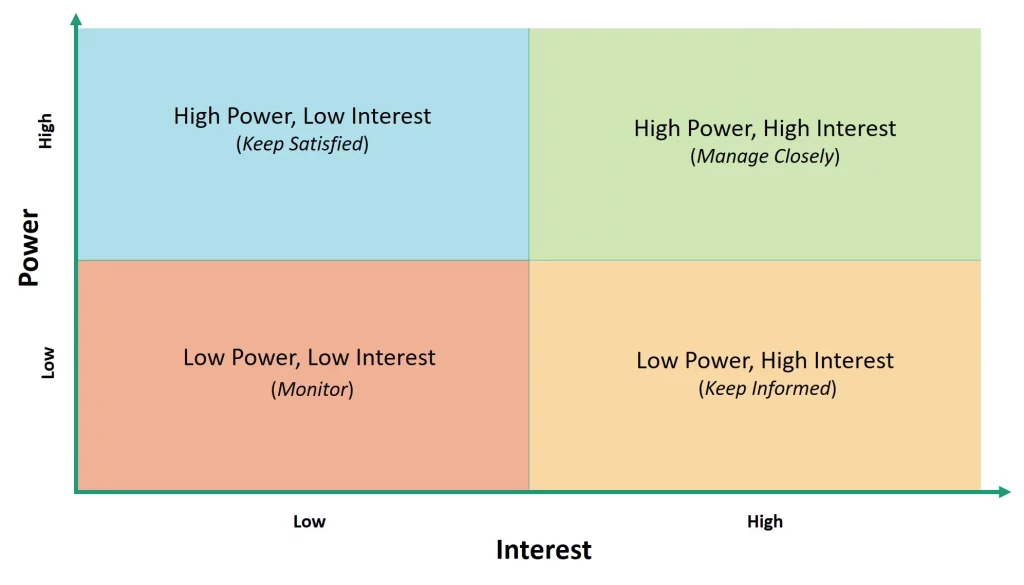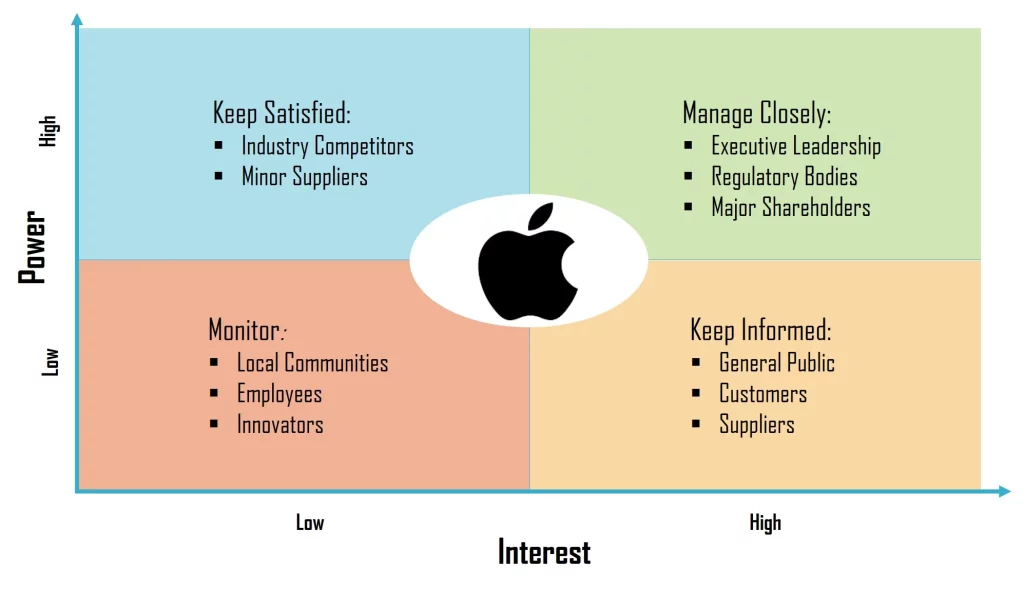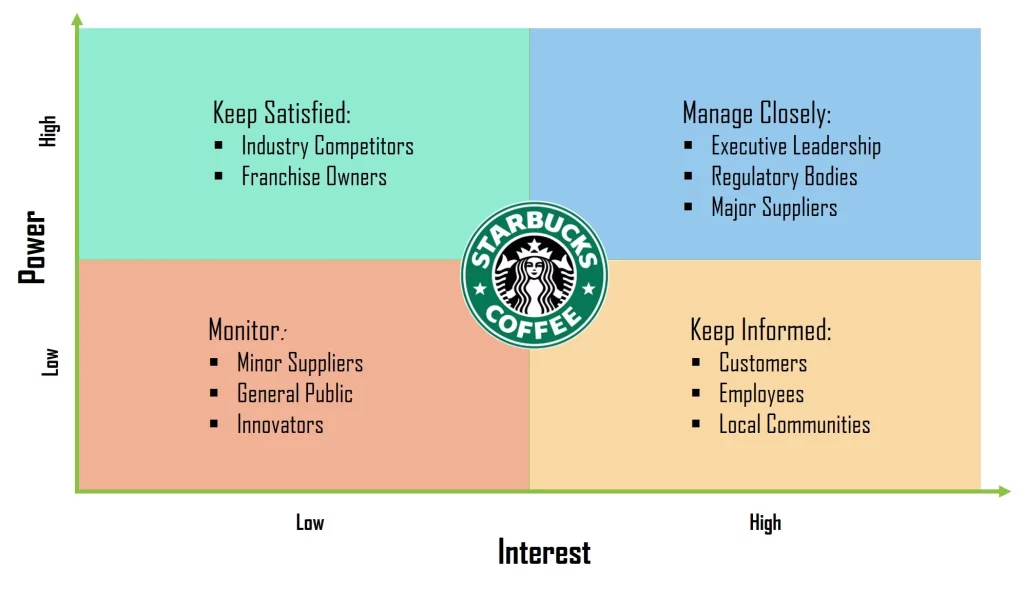
A power-interest grid or matrix is a tool used in stakeholder analysis to visually represent stakeholders based on their level of power and their level of interest in a project, initiative, or organization. The grid helps categorize stakeholders into different quadrants, providing insights into how to manage relationships and engage with each stakeholder group effectively.
Key Components: Axes & Quadrants
Axes of the Power-Interest Grid
The two axes of the grid or matrix represent:
- Power: The level of influence or authority a stakeholder has over the project or organization.
- Interest: The degree to which a stakeholder is affected by or interested in the project’s outcomes.
Quadrants of the Power-Interest Grid
The power-interest grid typically consists of four quadrants:
- High Power, High Interest (Manage Closely): Stakeholders in this quadrant are both powerful and highly interested. They require close management and engagement to ensure their needs are addressed, and they are supportive of the project.
- High Power, Low Interest (Keep Satisfied): Stakeholders in this quadrant have high power but low interest. While they can significantly influence the project, their lower interest suggests a focus on keeping them satisfied without overwhelming them with unnecessary information.
- Low Power, High Interest (Keep Informed): Stakeholders in this quadrant have high interest but low power. They should be kept informed about project progress and decisions but may not require extensive management.
- Low Power, Low Interest (Monitor): Stakeholders in this quadrant have both low power and low interest. Monitoring is sufficient, and resources are generally not allocated for extensive engagement.
The power-interest grid helps organizations tailor their communication and engagement strategies based on the unique characteristics of each stakeholder group. Other tools that can be applied in conducting a stakeholder analysis are stakeholder mapping and stakeholder identification matrix.
Examples
Apple Power-Interest Grid Example

Notes:
- Manage Closely (High Power, High Interest):
- Keep Satisfied (High Power, Low Interest):
- Keep Informed (Low Power, High Interest):
- Monitor (Low Power, Low Interest):
McDonald’s Corp. Power-Interest Grid Example

Notes:
- Manage Closely (High Power, High Interest):
- Keep Satisfied (High Power, Low Interest):
- Keep Informed (Low Power, High Interest):
- Monitor (Low Power, Low Interest):
Starbucks Corp. Power-Interest Grid Example

Notes:
- Manage Closely (High Power, High Interest):
- Keep Satisfied (High Power, Low Interest):
- Keep Informed (Low Power, High Interest):
- Monitor (Low Power, Low Interest):
Strengths vs. Limitations
| Strengths | Limitations |
|---|---|
| 1. Clear Visualization: Provides a clear visual representation of stakeholder positions based on power and interest. | 1. Simplification: May oversimplify complex stakeholder relationships and dynamics. |
| 2. Prioritization Guidance: Aids in prioritizing stakeholder engagement efforts by focusing on high-power, high-interest stakeholders. | 2. Static Representation: Assumes static positions, whereas stakeholder dynamics can change over time. |
| 3. Resource Allocation: Guides resource allocation, helping allocate resources effectively to manage influential stakeholders. | 3. Subjectivity: Assessments of power and interest may be subjective and vary among stakeholders and analysts. |
| 4. Strategic Decision Support: Assists in making strategic decisions by considering the influence and interest of key stakeholders. | 4. Lack of Context: Doesn’t provide a comprehensive understanding of the specific context or reasons behind stakeholder positions. |
| 5. Communication Planning: Supports tailored communication strategies based on stakeholder positions. | 5. Neglect of Other Attributes: Focuses primarily on power and interest, omitting other important attributes that may influence stakeholder engagement. |
| 6. Alignment with Goals: Aligns stakeholder engagement with organizational goals by categorizing stakeholders into manageable groups. | 6. Influence Changes: Power and interest levels can change, and the grid may not dynamically reflect these changes. |
| 7. Quick Assessment: Offers a quick assessment of stakeholder importance and potential impact on the project or organization. | 7. No Actionable Insights: While informative, it may not always provide actionable insights for engagement strategies. |
| 8. Cross-Functional Use: Can be easily understood and utilized by cross-functional teams for collaborative decision-making. | 8. Assumes Homogeneity: Treats stakeholder groups as homogeneous, overlooking internal differences within each group. |
| 9. Adaptable to Projects: Applicable to various projects and initiatives, providing a versatile tool for stakeholder management. | 9. Overemphasis on Power: Overemphasizes power dynamics, potentially overlooking the importance of interest or collaboration potential. |
Tips on How to Create an Effective Power-Interest Grid
- Clearly Define Objectives: Clearly articulate the objectives of creating the Power-Interest Grid. Understand what insights or decisions you aim to derive from the analysis.
- Identify Relevant Attributes: Choose relevant attributes for assessing power and interest. Consider factors such as influence, authority, and the level of interest or involvement in the project.
- Gather Comprehensive Data: Conduct thorough research to gather accurate and up-to-date information about each stakeholder. Consider both quantitative and qualitative data to inform your assessments.
- Engage Stakeholders: Whenever possible, engage directly with stakeholders to gain insights into their perspectives, expectations, and levels of interest and influence.
- Use a Consistent Scale: Establish a consistent and clear scale for assessing power and interest. This could be a numerical scale or qualitative categories such as low, moderate, and high.
- Collaborate with Cross-Functional Teams: Involve cross-functional teams in the analysis to ensure diverse perspectives and a comprehensive understanding of stakeholder relationships.
- Regularly Update the Grid: Recognize that stakeholder dynamics can change over time. Regularly update the Power-Interest Grid to reflect evolving relationships and shifting influences.
- Prioritize Key Stakeholders: Prioritize stakeholders based on their positions on the grid. Focus on managing high-power, high-interest stakeholders more closely, while considering different strategies for other quadrants.
- Consider Context and Nuance: Acknowledge the context and nuances behind stakeholder positions. Understand the reasons for their power and interest levels, taking into account industry dynamics and organizational specifics.
- Use Visual Cues: If presenting the grid visually, use color-coding or other visual cues to highlight different stakeholder groups or draw attention to specific insights.
- Combine with Other Analyses: Consider complementing the Power-Interest Grid with other analyses, such as a Stakeholder Analysis Matrix or a Stakeholder Mapping exercise, to gain a more holistic understanding.
- Solicit Feedback: Seek feedback from relevant stakeholders and team members. Their insights can validate your assessments and provide additional perspectives.
- Customize for Specific Projects: Tailor the Power-Interest Grid to the specific needs and context of each project or initiative. Consider adjusting attributes or scales based on project requirements.
- Document Assumptions: Clearly document any assumptions made during the analysis. This transparency ensures that others understand the basis for your assessments.
By following these tips, you can enhance the accuracy and effectiveness of your Power-Interest Grid, making it a valuable tool for strategic decision-making and stakeholder management.
In conclusion, the goals of a Power-Interest Grid are to visually categorize stakeholders based on their level of power and interest, providing a strategic framework for prioritizing engagement efforts, understanding stakeholder dynamics, and guiding decision-making in projects or organizations.
